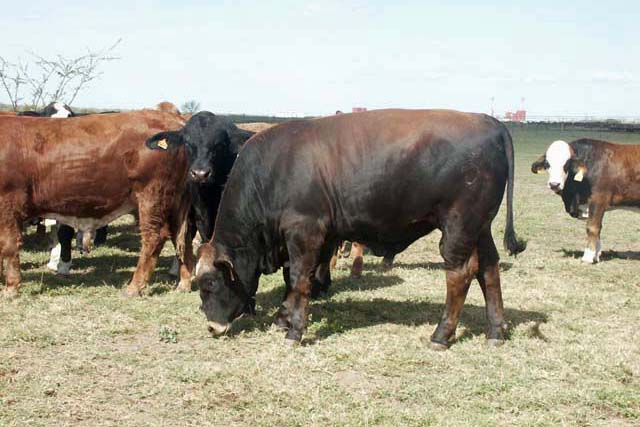Farm & Ranch
[AgriLife Today] Value of bull to commercial herd exceeds ‘relative’ value

By: Paul Schattenberg
Writer: Paul Schattenberg, 210-859-5752, [email protected]
Contact: Dr. Joe Paschal, 361-265-9203, [email protected]
CORPUS CHRISTI – The value of bulls in commercial herds goes beyond the “relative” value typically ascribed to them in market pricing, said a Texas A&M AgriLife Extension Service expert.
“In publications referencing cattle values for commercial producers as well as reports from beef breed associations, the value of a bull is often given as equivalent to the average value of five weaned calves,” said Dr. Joe Paschal, AgriLife Extension livestock specialist, Corpus Christi. “This has been a long-held comparison for determining the value of a bull, but it really doesn’t take into account all aspects of what bulls provide to the herd.”
Paschal said the value of one bull to five weaned calves resulted from a relative equivalency identified as market prices fluctuated over the past several years.
“At least up until around 2010, producers paid less than 50 percent of the value of those five calves on a bull,” Paschal explained. “Then from 2011 until 2015 producers began to pay more, including up to 100 percent of the value of five calves in 2013. Then in 2015, producers paid up to 150 percent of the value of five calves for one bull. And when calf prices dropped in 2016, the ratio dropped back to about 115 percent – between $5,000 and $5,250 – closer to the average value of the five calves.”
But this ratio doesn’t fully reflect the additional value bulls supply to the herd, Paschal said.
“Bulls supply the genetics for the next generation of replacement females in most commercial herds except those strictly using terminal crossing,” he said. “It should be remembered that bulls are more than just ‘cow fresheners’ as my former colleague, Dr. Rick Machen, retired AgriLife Extension livestock specialist in Uvalde, was fond of saying. As such, their value goes beyond the market price for five head of calves.”
Paschal said if a bull is used for three years and the producer does not introduce any outside female replacements into the herd, that bull will then be responsible for up to 87 percent of the cowherd’s genes.
“A lot of products and equipment are touted as being the best investment a cattle producer can make, but a good bull is the only thing that can really match that description,” he said. “If you maintain a closed herd, the genes entering the cow herd will come completely from the bulls you select, and that’s a huge contribution – for better or worse – to the herd’s overall genetic makeup. When you look at it from that perspective, you see just how valuable a good bull is to a commercial cow herd.”
-30-
Find more stories, photos, videos and audio at http://today.agrilife.org
Farm & Ranch
Ag Elsewhere: Wyoming

By Tressa Lawrence
Babies are tucked away in every nook and cranny. Many ranchers across Wyoming have baby animals popping up all over this time of year.
Farm & Ranch
Ag Elsewhere: Montana

By Lindsey Monk
Another load of grain in to keep feeding the calves until the green grass can really start popping.
Farm & Ranch
Meanwhile, Back at the Ranch….

By Rayford Pullen | [email protected]
Spring has sprung and hopefully the rains will continue where our country will heal from the previous droughts and our grasses will thrive. We are especially hopeful for the Panhandle of Texas where our neighbors and friends have been dealt a deadly blow to homes, ranges, livestock, and people. Keep them in your prayers as they will not be able to return to normal for many years if at all. Having lost their ability to benefit from this great cattle market is a double whammy for all of them.
Now is the time of year when we need to take care of business as it relates to our new calves that have been hitting the ground this spring. First and foremost is vaccinating for Blackleg followed by deworming with a white wormer and the IBR complex. Blackleg is a soil-born disease and with pastures extremely short this spring our calves have been grazing the green grass as soon as it shows itself, making them even more vulnerable to picking contaminates from the soil.
To read more, pick up a copy of the April issue of NTFR magazine. To subscribe by mail, call 940-872-5922.
-

 Country Lifestyles1 year ago
Country Lifestyles1 year agoScott & Stacey Schumacher: A Growth Mindset
-

 Equine7 months ago
Equine7 months agoThe Will to Win
-

 Country Lifestyles7 years ago
Country Lifestyles7 years agoStyle Your Profile – What your style cowboy hat says about you and new trends in 2017
-

 Country Lifestyles4 years ago
Country Lifestyles4 years agoAmber Crawford, Breakaway Roper
-

 HOME7 years ago
HOME7 years agoGrazing North Texas – Wilman Lovegrass
-

 Country Lifestyles7 years ago
Country Lifestyles7 years agoDecember 2016 Profile, Rusty Riddle – The Riddle Way
-

 Country Lifestyles8 years ago
Country Lifestyles8 years agoJune 2016 Profile – The man behind the mic: Bob Tallman
-

 Country Lifestyles8 years ago
Country Lifestyles8 years agoCowboy Culture with Clay Reid – Being a Man






